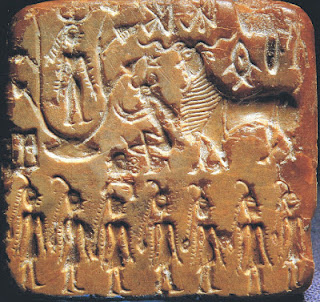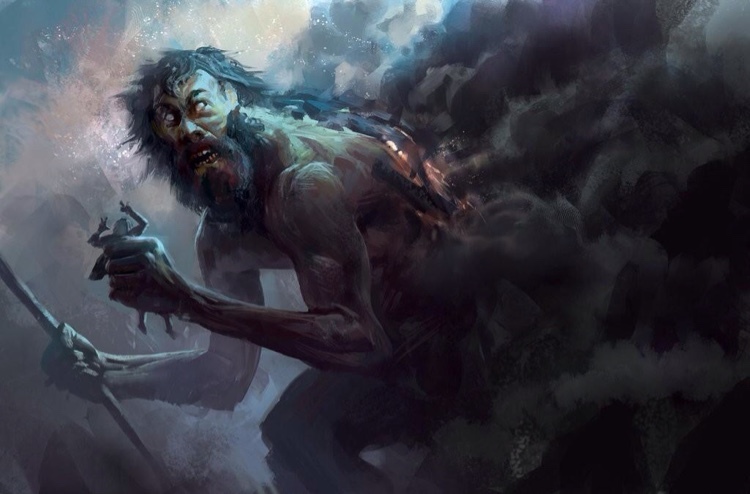MAHADEV, BADADEV AND THE PASHUPATI OF INDUS VALLEY
The Gondi are a Dravidian ethno-linguistic group. They are the native speakers of the Gondi language which belongs to Dravidian language family. They are one of the largest tribal groups in India.They are spread over the states of Madhya Pradesh, Maharashtra,Chhattisgarh, Uttar Pradesh, Telangana, Andhra Pradesh, Bihar and Odisha. They are listed as a Scheduled Tribe for the purpose of India's system of positive discrimination.They are an Adivasi group or indigenous people of India.
Many astronomical ideas were known to ancient Gonds. Gonds had their own local terms for the Sun, Moon, Milky Way, and constellations. Most of these ideas were basis for their time-keeping and calendrical activities. Majority of Gond people still worship nature, but like many other tribes in India Gonds can also be seen following different religions. After the major influence of Hinduism in tribal areas some of them started following Hindu religion, which retains the animist beliefs of nature, and ancestor worship.
nds are organically connected with nature. Their pantheon represents all the aspects of nature. Badadev, the greatest of all gods, is represented by the saja tree. Thakur Dev is associated with the pakri tree, the god Karma Dev who is represented by the karma tree. Gonds believe in the supernatural forces. Their protectors are the spirits, the gods and goddesses who keep them from harm. Their songs, dance forms, myths and legends, folk tales, customs and rituals reflect a close bond with nature and are all inter-related.
Oral narratives, like the Gondwani and Ramayani hold the community together. The Gond creation myth tells of the greatest of gods, Badadev who fashioned the earth and every creature on it. There are myths about the origin of the Gond kings, of different trees. Bada Dev is believed to live in a Saja tree (Boswellia serrata). As such, the Saja tree is the most sacred tree of the Gonds.
Bada Dev is invoked under a Saja tree by a Gond Pardhan. The Pardhans are the musicians, story-tellers, and genealogists of the Gonds. For ages, they have carried the collective memory of the Gond communities. A Pardhan invokes Bada Dev by sitting under a Saja tree and playing a musical instrument called Bana.On listening to the melodious sound of the Bana, and the song sung by the Pardhan, Bada Dev awakens from his slumber and comes down the Saja tree. He is offered mahua liquor and the sacrifice of a goat. Sometimes a goat is dedicated to him a year beforehand, and allowed to wander loose in the village in the name of Bura Deo, and given good food, and even called by the name of the god.
THE GOND MYTH OF BADADEV
The Gonds were seven brothers. They sowed jute in the field. In a few days, the jute began to grow. One day they saw a handsome young man galloping on his horse right through their field. The hooves were trampling the jute saplings. They rushed behind the young man. The youngest brother was so scared that his stomach got upset. He went to the nearby ditch to relieve himself. The other six brothers chased the horseman. The field was quite big. At the edge of it was a Saja tree. Seeing the Gond brothers chasing him, the horseman went under the Saja tree and disappeared into it along with his horse. The Gonds saw him vanish into the tree. They instantly understood This is their Bada Dev who came riding through our field on his white horse. How unfortunate they are that they could not recognise him. Now he is angry with them. He has disappeared into the Saja tree. They erected a platform under the Saja tree. They offered rar lentils, Sacrificed a white rooster. Sprinkled liquor. Folded their hands in prayer. Went on pleading But Bada Dev was angry. He did not come out of the Saja tree At this point the youngest brother turned up. He found out what had happened He said, he will find a way. It might please Bada Dev. He made a one-stringed instrument from the wood and playing on it and began to sing. The notes began to resound in the woods. In the song he began to sing praised the glory of Bada Dev. Listening to the song Bada Dev was pleased and he made an appearance in the trunk of the Saja tree. He blessed the youngest brother by placing his hand on his head and said "Whenever you sing my song playing this instrument, Ill make an appearance. This instrument of yours will be called Bana". Bada Dev accepted everybodys offerings and once again vanished into the Saja tree.
Since that time, the youngest brother came to be known as a Pardhan and he played the Bana to please Bada Dev. He gave up working on the land; the remaining six brothers decided to take care of his daily needs.Once a year, the Pardhan visits his Gond Yajmans (patrons) in order to narrate mythical stories and invoke Bada Dev under the Saja tree. The Gond patron repays the Pardhan story-singer with grains, jewellery, clothes and utensils.
THE GOND AND THE INDUS VALLEY CIVILIZATION
The imagery on the seal is similar to the Gond legend just described. The deity in the tree, who has often been termed as a tree-spirit, can very easily be thought of as the Gond deity Bada Dev appearing in the trunk of the Saja tree. The kneeling worshipper appears to be a Gond priest. The seven primal Gond brothers can be seen at the bottom.
The pedestal in front of him has an object which resembles the tray used in traditional Hindu pujas in which the holy fire burns. The animal behind the kneeling worshipper has already been identified by scholars as a markhor, a species of wild goat which abounds along the banks of the Indus River. The markhor is probably being offered as a sacrifice to the tree-spirit. This agrees with the Gond custom of offering a goat as a sacrifice to Bada Dev.
It has been noted by scholars that the seated yogi of the Pashupati seal looks similar to the tree-spirit of the Sacrifice seal. Both of them are wearing a horned head-dress and bangles. The visual similarity suggests that they may represent the same deity.











ReplyDeleteThanks for sharing with us
We also provide the Puja Thaali, yantra, Shiva Statues
Rudraksha
Brass statues of Hindu Gods and goddesses including Nataraja, Ganesha , Krishna, Vishnu, Saraswati, Durga brass statues
For more informartion please visit our site:
Hindutemplestores
http://uralathu.blogspot.com/2021/01/4.html
ReplyDelete